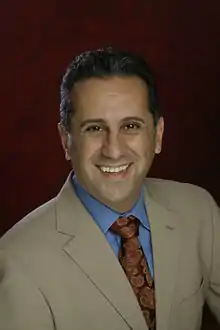Siavash Alamouti
Siavash Alamouti is the EVP of Innovation R&D at Wells Fargo and the executive chairman of mimik. Prior to that, Siavash Alamouti was the President and CEO of the edge cloud software company mimik.[1]
Siavash Alamouti | |
|---|---|
 | |
| Born | 1962 |
| Nationality | Iranian |
| Citizenship | USA, Canada |
| Alma mater | Sharif University |
| Occupation | EVP, Head of R&D, Wells Fargo & Executive Chairman of mimik technology |
Early life
Siavash Alamouti was born in 1962 in Tehran, Iran, and attended Sharif University[2] in 1980 for one year and was expelled after the cultural revolution.
Today, he holds dual citizenship of Canada and USA.[3]
Career
Prior to mimik, Siavash Alamouti was the Group R&D Director at Vodafone Group [4][5]
Prior to Vodafone, he was an Intel Fellow and the CTO of Mobile Wireless Group at Intel. Alamouti its technology champion for Mobile WiMAX[6][7]
Prior to Intel, he was the Director of R&D and before his departure, the CTO of the smart antenna WiFi startup called Vivato. While at Vivato, he championed fundamental changes to regulations in the unlicensed band to enable the use of smart antennas for WiFi.[8]
He started his professional career at MPR Teltech in Vancouver[9] where he worked on early mobile data protocols including CDPD.
In 1995, he joined McCaw Cellular, now AT&T Wireless as a Senior Scientist where he worked on the physical and MAC layer design of United States’ first commercial OFDM/MIMO system known as Project Angel.[10][11]
During that project, he invented a 2xN MIMO scheme which today is referred to by some as the “Alamouti Code”[12] and has been adopted in various wireless standards including WiFi and LTE and is included in billions of wireless devices . Alamouti’s 1998 paper in IEEE Journal on Selected Areas of Communications[13] was by IEEE Communication Society for publication in, “The Best of the Best: Fifty Years of Communications and Networking Research.”
In 2001, AT&T Wireless Services Inc was assigned a patent citing Alamouti and Tarokh as co-inventors of Transmitter diversity technique for wireless communications.[14]
In 1999, Tarokh, Jafarkhani, and Calderbank, published a paper, categorized the Alamouti Code as a Space-Time Block code, and generalized the code to more transmit antennas. In 2013, Alamouti, Tarokh and Jafarkhani, received an award for the invention of Space-time-Block codes.[15]
Alamouti, received B.A.Sc. and M.A.Sc. Degrees in Electrical Engineering from the University of British Columbia in 1989 and 1992 respectively.[16]
References
- "mimik technology announces the appointment of new President and CEO".
- "Sharif University of Technology".
- "Siavash Alamouti on How Technology Can Empower the Oppressed".
- "Vodafone Appoints Siavash Alamouti as Group Research and Development Director".
- Memarian, Jahandad (7 March 2018). "Siavash Alamouti on How Technology Can Empower the Oppressed". Medium.
- "HSPA no threat to WiMAX, says Intel".
- "3G Vs 4G: Intel pushes for WiMAX".
- National Research Council; Computer Science and Telecommunications Board; Committee on Wireless Technology Prospects and Policy Options (17 May 2004). Summary of a Forum on Spectrum Management Policy Reform. National Academies Press. ISBN 978-0-309-16598-3.
- "Waiting on a Leader: Vancouver's Tech History".
- "MCCAW'S PROJECT ANGEL GIVEN LIFE BY AT&T WIRELESS SERVICES".
- "Method for frequency division duplex communications".
- "MIMO Space Time Block Coding and Alamouti Codes".
- S.M. Alamouti (October 1998). "A simple transmit diversity technique for wireless communications" (PDF). IEEE Journal on Selected Areas in Communications. 16 (8): 1451–1458. doi:10.1109/49.730453.
- Siavash Alamouti and Vahid Tarokh. "United States Patent No. 6,185,258". United States Patent and Trademark Office. Retrieved 2013-03-06.
- "IEEE Eric E. Sumner Award Recipients".
- "UBC 1992 Spring Alamouti Siavash". Missing or empty
|url=(help)